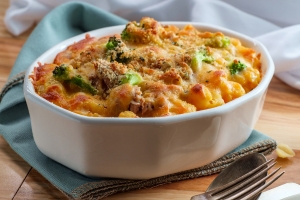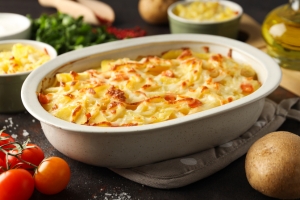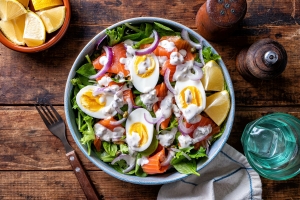The smell of a warm breakfast casserole wafting through the kitchen is a comforting way to start any day. But for those managing diabetes, breakfast can be a bit more complicated than just enjoying a delicious meal. It’s about balancing flavor with blood sugar control. That’s where these 16 low-carb breakfast casseroles come in. They’re not just delicious; they’re designed to fit seamlessly into a diabetes-friendly meal plan and are perfect for prepping ahead, so you can grab a healthy breakfast and go!
Why Low-Carb and Diabetes Are a Perfect Match

Before we dive into these mouthwatering recipes, let’s talk about why low-carb eating is a game-changer for managing diabetes.
- Steady Blood Sugar: Carbohydrates break down into glucose, which raises blood sugar levels. By reducing carbs, you help prevent those spikes and crashes that can leave you feeling tired and unwell.
- Weight Management: Low-carb diets often lead to weight loss, which can significantly improve insulin sensitivity and make managing diabetes easier.
- Heart Health Boost: Many low-carb options are naturally rich in healthy fats and protein, which can improve cholesterol levels and reduce the risk of heart disease, a common concern for people with diabetes.
Are you sure you know which foods are truly low-carb? Find out here: 14 Sneaky High-Carb Foods to Avoid (and What to Eat Instead!)
Meal Prep: Your Secret Weapon for Healthy Eating

Meal prepping isn’t just a trend; it’s a powerful tool for taking control of your health, especially when you have diabetes. Here’s how it helps:
- Planned Choices: Mapping out your meals ahead of time helps you make considered decisions, avoiding those “grab-whatever’s-quickest” moments that can derail your blood sugar goals.
- Portion Perfection: Pre-portioning your casseroles into individual servings takes the guesswork out of serving sizes, making it easier to stick to your meal plan.
- Stress-Free Mornings: Imagine waking up to a ready-to-go breakfast. No rushing, no fuss, just a healthy meal waiting for you. That’s the magic of meal prep!
- No More Decision Fatigue: We all have those moments when hunger strikes, and willpower weakens. With prepped meals on hand, you’re less likely to make unhealthy choices when your stomach is growling.
You Might Also Like: 7 Easy Meal Prep Hacks for Diabetic-Friendly Meals
Now, let’s get cooking!
A Note About the Recipes
To make it easier for you to choose the perfect casserole, I’ve provided the nutritional information for each one, including calories, carbs, protein, and fat. Remember that these are estimates, and actual values may vary slightly depending on the specific ingredients and measurements you use.
Important Note: While these casseroles are designed to be diabetes-friendly, it’s always a good idea to check with your doctor or a registered dietitian before making any big changes to your diet. They can offer personalized advice and make sure your meal plan aligns with your individual needs.
Savory Sensations: Casseroles with a Hearty Kick

If you love bold flavors and satisfying meals, these casseroles are for you. They’re packed with protein and veggies, making them a perfect way to fuel your morning.
- Sweet Potato, Sausage & Goat Cheese Egg Casserole This hearty casserole combines the sweetness of sweet potatoes with savory sausage and tangy goat cheese (Nutrition: Calories 250, Carbs 18g, Protein 17g, Fat 12.5g).
- Sheet-Pan Eggs with Spinach & Ham This simple sheet-pan recipe is perfect for busy mornings. Just toss spinach, ham, and eggs together and bake (Nutrition: Calories 165, Carbs 3g, Protein 14g, Fat 11g).
- Zucchini, Corn & Egg Casserole This summery casserole is a delicious way to enjoy fresh zucchini and corn (Nutrition: Calories 263, Carbs 14.4g, Protein 18.2g, Fat 14.8g).
- Broccoli, Ham, and Mozzarella Baked with Eggs This cheesy casserole is a great way to use up leftover broccoli. It’s also a good source of protein and calcium (Nutrition: Calories 205, Carbs 4.1g, Protein 19.8g, Fat 11.6g).
Veggie Powerhouses: Casseroles Bursting with Goodness

These casseroles are loaded with vegetables, offering a nutritious and flavorful start to your day.
- Kale and Feta Breakfast Casserole This vibrant casserole features the earthy flavors of kale and feta cheese, along with a medley of other vegetables (Nutrition: Calories 200, Carbs 1.9g, Protein 14.3g, Fat 14.3g).
- Breakfast Casserole with Spinach and Goat Cheese This lighter option highlights the earthy flavors of spinach and goat cheese (Nutrition: Calories 148, Carbs 3g, Protein 12g, Fat 10g).
- Caprese Zucchini Casserole This Italian-inspired casserole combines zucchini, tomatoes, mozzarella, and basil for a fresh and flavorful dish (Nutrition: Calories 85, Carbs 4.4g, Protein 4.3g, Fat 5.5g).
Flavor Fusion: Casseroles with Unexpected Twists

These casseroles bring together unique flavor combinations to add some excitement to your breakfast routine.
- Breakfast Casserole with Cottage Cheese, Bacon, and Feta This casserole offers a surprising twist with the tanginess of cottage cheese and feta, balanced by the salty crunch of bacon (Nutrition: Calories 251, Carbs 3.7g, Protein 21.2g, Fat 16.5g).
- Sausage, Mushrooms, and Feta Baked with Eggs Earthy mushrooms and salty feta complement the savory sausage in this flavorful casserole (Nutrition: Calories 338, Carbs 4.2g, Protein 20g, Fat 27.1g).
- Bobbi’s Egg Casserole with Cheese and Green Chiles If you like a little heat, this casserole with green chiles is a great option (Nutrition: Calories 307, Carbs 6g, Protein 23g, Fat 21g).
Meat Lovers Rejoice: Casseroles Packed with Protein

For those who crave a hearty dose of meat in their breakfast, these protein-rich casseroles will hit the spot.
- Egg & Sausage Casserole This classic casserole is a crowd-pleaser, combining eggs, sausage, cheese, and vegetables (Nutrition: Calories 344, Carbs 2.5g, Protein 24g, Fat 25.8g).
- Pork Lover’s Keto Breakfast Casserole This casserole goes all out on the protein with bacon, sausage, and ham. (Nutrition: Calories 462, Carbs 4.2g, Protein 41g, Fat 31g)
- Breakfast Casserole with Italian Sausage Bring the flavors of Italy to your breakfast table with this casserole featuring Italian sausage, peppers, and onions. (Nutrition: Calories 458, Carbs 5.3g, Protein 32g, Fat 34g)
Elegant and Earthy: Casseroles with Sophisticated Flavors

These casseroles offer refined flavors and textures, perfect for a special breakfast or brunch.
- Asparagus, Mushrooms, and Goat Cheese Breakfast Casserole This recipe highlights the fresh flavors of spring with asparagus, mushrooms, and creamy goat cheese. (Nutrition: Calories 241, Carbs 4g, Protein 19.4g, Fat 17g).
- Spinach and Mozzarella Egg Bake This simple and satisfying casserole features the classic combination of spinach and mozzarella cheese. (Nutrition: Calories 215, Carbs 3.6g, Protein 18.3g, Fat 14.1g)
A Classic with a Twist

- Easy Loaded Baked Omelet Muffins These individual omelet muffins are perfect for meal prepping and a great way to use up leftover vegetables and cheese. (Nutrition: Calories 230, Carbs 4.5g, Protein 16.1g, Fat 16.2g)
These 16 low-carb breakfast casseroles are your ticket to mornings that are both delicious and diabetes-friendly. With a little prep work, you can wake up to a satisfying meal that fuels your day and helps keep your blood sugar in check. So, why not give these recipes a try? Your taste buds—and your health—will thank you. And if you found these ideas helpful, feel free to share the inspiration on Pinterest!
Did you find these make-ahead breakfast casserole recipes helpful? Pin this article to your favorite recipe board on Pinterest to save it for later and share the diabetic-friendly, low-carb goodness!








12 Responses
This is a great list! I’m always looking for new breakfast ideas that won’t spike my blood sugar. I’m curious, though, about the sweet potato in the first recipe. Sweet potatoes are delicious, but I always thought they were higher in carbs than regular potatoes. Are they okay for someone with diabetes? I have type 2 diabetes.
Hi Sarah, thanks for the question! You’re right to consider the carbs in sweet potatoes. While they do have a bit more natural sugar than white potatoes, they also have a lower glycemic index, meaning they cause a slower, more gradual rise in blood sugar. Plus, they’re packed with fiber, which also helps with blood sugar control. In moderation, and as part of a balanced meal like this casserole, sweet potatoes can be a healthy and delicious option for people with type 2 diabetes. But, of course, it’s always best to monitor your blood sugar levels and see how they respond to different foods.
I love the idea of meal prepping breakfast casseroles, but I’m a little worried about reheating eggs. Do they get rubbery or dry when you reheat them? Any tips for keeping them moist and delicious throughout the week? I don’t want to waste food and I want to eat healthy food.
That’s a valid concern, Jessica! Reheated eggs can sometimes be a bit dry. Here are a few tips to help:
Slightly undercook the casserole initially: This will prevent them from overcooking when you reheat.
Reheat gently: Use a lower temperature in the oven or microwave, and cover the casserole to trap moisture.
Add a splash of liquid: A tablespoon of milk or water before reheating can help rehydrate the eggs.
Don’t overheat: Reheat just until warmed through to avoid that rubbery texture.
I hope these tips help!
This is a really helpful article! I love the variety of casseroles you’ve included. I’m trying to incorporate more vegetables into my diet, and these recipes seem like a great way to do that. I’m wondering though, are there any vegetables that are particularly good or bad for blood sugar control in these types of dishes?
Hi Mary, thanks for your comment! I’m glad you appreciate the variety. You’re thinking along the right lines – vegetables are a fantastic addition to a diabetes-friendly diet. In the context of these casseroles, most non-starchy vegetables are excellent choices.
Specifically, leafy greens like spinach and kale are packed with nutrients and fiber and have a minimal impact on blood sugar. Broccoli, cauliflower, zucchini, and bell peppers are also great options. They add bulk, flavor, and important vitamins and minerals without significantly raising blood sugar. It’s best to be a bit more mindful of starchy vegetables like potatoes, corn, and peas, as they contain more carbohydrates. While they can be included in moderation, it’s important to be aware of portion sizes and balance them with other lower-carb ingredients, as is done in the sweet potato casserole recipe. In general, focusing on a variety of colorful non-starchy vegetables is a great way to boost the nutritional value of these casseroles and support blood sugar management.
These recipes look so convenient for busy mornings! I’m definitely going to try some of them. My question is about cheese. Many of these casseroles include cheese, and I know some cheeses are higher in fat than others. Should I be concerned about the fat content in these recipes, especially if I’m also watching my cholesterol?
Hi Jennifer, thanks for your question! I’m happy to hear you’re planning to try the recipes. You’re right to be mindful of the fat content, especially if you’re also watching your cholesterol. While these casseroles are designed to be lower in carbs, some do contain cheese, which can contribute to the fat content.
The good news is that the fat in cheese isn’t necessarily all bad. Cheese provides calcium and protein, and some studies suggest that dairy fat may not have as negative an impact on cholesterol as previously thought. However, it’s still wise to choose lower-fat cheese options when possible. For example, you could use part-skim mozzarella, reduced-fat cheddar, or even consider using stronger-flavored cheeses like feta or goat cheese in smaller amounts to still get a good flavor without as much fat. You can also balance the fat content of the casseroles by including plenty of lean protein sources like chicken, turkey, or lean sausage, and by loading up on vegetables. If you have specific concerns about your cholesterol, it’s always best to consult with your doctor or a registered dietitian who can provide personalized dietary advice.
Okay, I’m intrigued! I’ve been trying to get my husband to eat healthier since his diabetes diagnosis, but he’s a “meat and potatoes” kind of guy. These casseroles sound like they might actually get him excited about breakfast again. I’m especially eyeing that Pork Lover’s Keto Breakfast Casserole – maybe I can sneak in some extra veggies without him noticing, haha! But I’m a little confused about something. If these are low-carb, how can they include ingredients like sweet potatoes or corn? Aren’t those pretty high in carbs? Also, are these really freezer-friendly? I’ve had bad luck freezing egg dishes before… they always turn out watery.
Hi Deborah! Thanks for your comment! I totally get it – it can be tough to change eating habits, especially when dealing with a “meat and potatoes” fan! I think the Pork Lover’s is a great starting point. And yes, you can totally sneak in extra veggies!
Regarding your question about sweet potatoes and corn: You’re right, they do have more carbs than, say, spinach or broccoli. However, in the context of a balanced meal and in moderation, they can still fit into a diabetic-friendly diet. It’s all about portion control and watching the overall carb count for the entire meal. These recipes aim to strike that balance. They provide nutritional info, so you can make informed choices. As for freezing, I hear you! The key is to let the casserole cool completely before freezing and to thaw it thoroughly in the fridge overnight before reheating. This helps minimize excess moisture. You might also want to underbake them just a tad before freezing, so they don’t overcook when reheated. Hope this helps! Let me know how it goes with the Pork Lover’s!
These look yummy, but I have a question about substitutions. I’m not a big fan of goat cheese (it’s a texture thing for me). Can I just swap it out for cheddar or another cheese in these recipes? And what about dairy-free alternatives? My daughter is lactose intolerant, but I’d love to make these for the whole family. Also, and this might sound silly, but is there a way to make these… less eggy? Sometimes the egg flavor is just too overpowering for me. Thanks for sharing these, by the way! It’s nice to see some diabetic-friendly recipes that aren’t just plain grilled chicken and steamed broccoli.
Hi Susan! Great questions! Absolutely, you can swap out the goat cheese. Cheddar, Monterey Jack, or even mozzarella would work well in most of these recipes. For a dairy-free option, there are some great plant-based cheeses on the market now that melt pretty well. Just be sure to check the labels, as some can be higher in carbs. As for making them less “eggy,” you could try adding a bit more of the other ingredients (veggies, meat) to balance out the egg. Also, using a mix of whole eggs and egg whites can sometimes help. Or, you can consider a dairy free milk alternative like almond milk to thin it out just a tad. I’m glad you’re finding the recipes inspiring! There’s definitely more to diabetic-friendly eating than just chicken and broccoli! Variety is the spice of life, right? Let me know which substitutions you try and how they turn out!